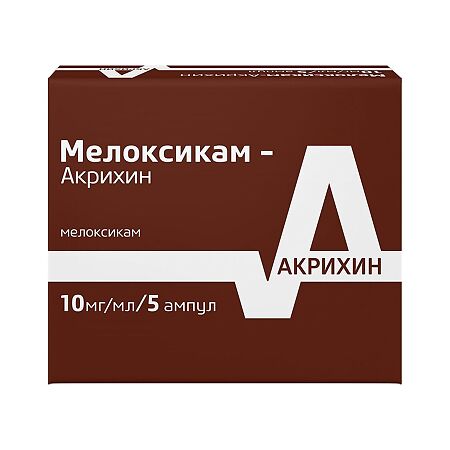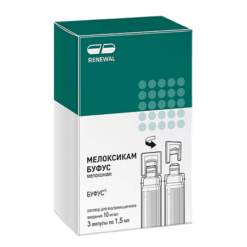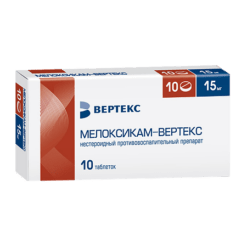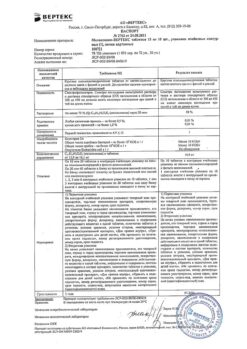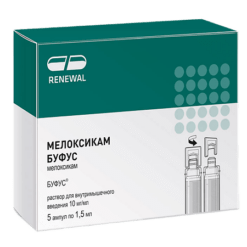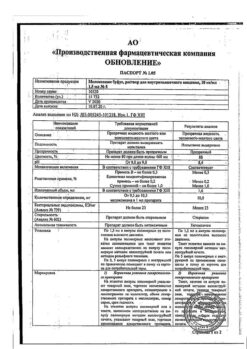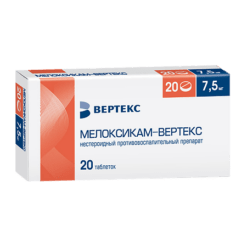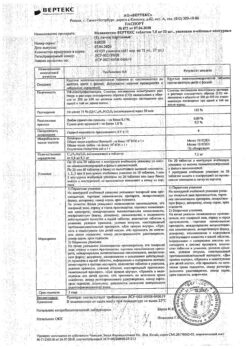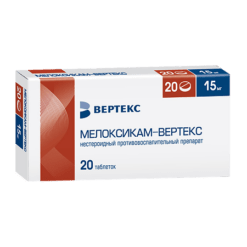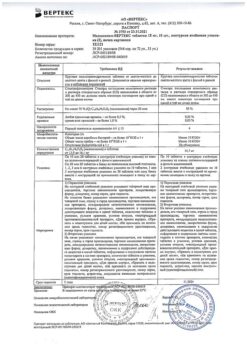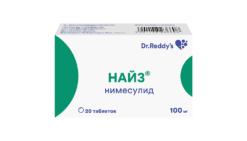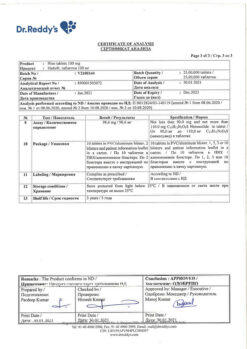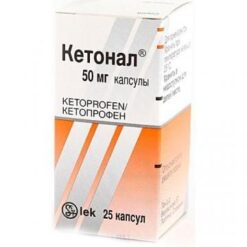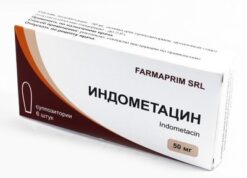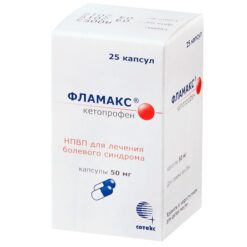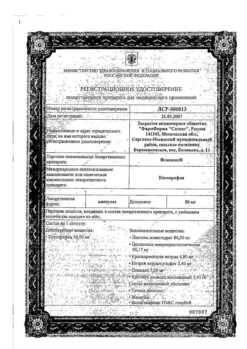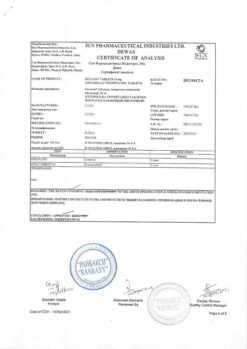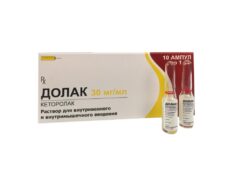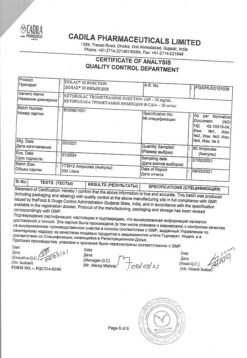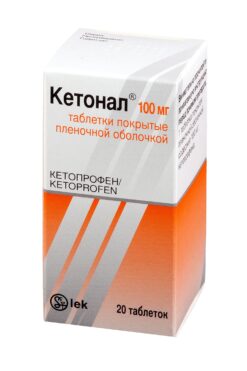No products in the cart.
Meloxicam-Acrichin, 10 mg/ml 1.5 ml 5 pcs.
€1.00
Out of stock
(E-mail when Stock is available)
Description
Pharmacotherapeutic group: Nonsteroidal anti-inflammatory drugs. Oxycams. Meloxicam.
ATC code: M01AC06
Pharmacological properties
Pharmacokinetics
Meloxicam is completely absorbed after intramuscular administration. The relative bioavailability compared to the bioavailability with oral administration is almost 100%. Therefore, no dose adjustment is required when switching from injectable to oral forms. After administration of 15 mg of the drug intramuscularly, the peak plasma concentration of 1.6-1.8 mcg/ml is reached after 60-90 minutes.
Meloxicam binds intensively with plasma proteins (especially with albumin) – 99%. Passes through the histohematic barriers, penetrates into the synovial fluid. The concentration in synovial fluid is 50% of that in plasma. Metabolized in the liver to inactive metabolites. It is excreted through the intestine and the kidneys (in about equal proportions), 5% of the daily dose (through the intestine) is unchanged. The elimination half-life varies from 13 to 25 hours after administration. Total plasma clearance is 7-12 ml/min.
Pharmacokinetics in special patient populations
Liver function insufficiency and mild renal insufficiency have no significant effect on the pharmacokinetics of meloxicam. Patients with moderately severe renal insufficiency have higher plasma clearance.
Decreased binding of meloxicam to proteins is observed in patients with terminal renal failure.
Elderly men have pharmacokinetic parameters similar to those of young men.
Elderly women have higher AUC values and longer half-life compared to younger patients.
Pharmacodynamics
Meloxicam is a nonsteroidal anti-inflammatory drug (NSAID) of the class of phenolic acid with anti-inflammatory, analgesic and antipyretic effects. The mechanism of the above effects is the ability of Meloxicam to inhibit the biosynthesis of prostaglandins, which are mediators of inflammation.
The mechanism of action is mainly due to the selective inhibition of cyclooxygenase-2 (COX-2), a specific enzyme involved in the development of inflammatory processes. Inhibition of COX-2 is thought to provide therapeutic effect of NSAIDs, whereas inhibition of COX-1 isoenzyme, which is always present, may cause gastric and renal side effects.
The selectivity of meloxicam against COX-2 has been confirmed in various test systems, both in vitro and in vivo.
The incidence of upper gastrointestinal perforations, ulcers and bleeding associated with meloxicam use was low and dependent on the dose amount of the drug.
Indications
Indications
Meloxicam is intended for initial and short-term (not prolonged) symptomatic treatment of inflammatory and degenerative joint diseases accompanied by pain syndrome, including/p>
– rheumatoid arthritis
– osteoarthritis
– ankylosing spondylitis (Bechterew’s disease)
Active ingredient
Active ingredient
Composition
Composition
One ampoule contains:
The active substance-meloxicam 15 mg,
auxiliary substances: meglumine, glycafurole, poloxamer, glycine, sodium chloride, sodium hydroxide, water for injection.
How to take, the dosage
How to take, the dosage
Intramuscular injection of the drug may be used only for 3-5 days (depending on the severity of the condition). Subsequently, treatment is continued with oral forms (tablets) or rectal suppositories.
The recommended dose is 7.5 mg or 15 mg once a day, depending on the intensity of the pain and the severity of the inflammatory process.
The drug is administered by deep intramuscular injection.
In patients at increased risk of adverse reactions and with significant renal impairment who are on hemodialysis, the dose should not exceed 7.5 mg per day. In mild to moderate renal function impairment (creatinine clearance is reduced not more than 25 ml/min from normal), as well as in cirrhosis of the liver in remission stage, no dose adjustment is required.
The drug should not be administered intravenously.
The maximum daily dose of meloxicam is 15 mg.
Combined use. The total daily dose of Meloxicam used as tablets, suppositories, oral suspension and injections should not exceed 15 mg.
In view of possible incompatibilities, the contents of Meloxicam ampoules should not be mixed in the same syringe with other medicinal products.
Interaction
Interaction
Concomitant use with other non-steroidal anti-inflammatory drugs (as well as with acetylsalicylic acid) increases the risk of erosive ulcerative lesions and bleeding of the gastrointestinal tract
with hypotensive medications, the effectiveness of the latter may decrease
With lithium preparations, cumulation of lithium and an increase in its toxic effects may occur (blood lithium concentration monitoring is recommended)
with methotrexate increases the side effects of the latter on the hematopoietic system (risk of anemia and leukopenia; periodic monitoring of total blood counts is indicated)
with diuretics increases the risk of acute renal failure in patients with dehydration. Patients taking Meloxicam in combination with diuretics should receive sufficient fluids, renal function should be investigated before starting therapy with Meloxicam
co-administration of NSAIDs and angiotensin II receptor antagonists (as well as ACE inhibitors) increases the effect of decreased glomerular filtration, which may lead to acute renal failure in patients with impaired renal function
intrauterine contraceptives may decrease the effectiveness of the latter
with anticoagulants (heparin, ticlopidine, warfarin), as well as with thrombolytics (streptokinase, fibrinolysin) the risk of bleeding increases (periodic monitoring of blood clotting is necessary)
with anticoagulants the risk of bleeding increases (periodic monitoring of clotting is necessary).
with cholestyramine, as a result of binding meloxicam, its excretion through the gastrointestinal tract is increased
Cyclosporines: NSAIDs may increase nephrotoxicity of cyclosporines indirectly through renal prostaglandins. Renal function should be monitored when these drugs are co-administered
with selective serotonin reuptake inhibitors increases the risk of gastrointestinal bleeding;
NSAIDs may cause retention of sodium, potassium, fluid and weaken the effects of saluretics. As a result, in predisposed patients, prescribing NSAIDs may lead to progression of heart failure and hypertension.
No pharmacokinetic drug interactions have been identified when meloxicam and antacids, cimetidine, digoxin, and furosemide are prescribed simultaneously.
Special Instructions
Special Instructions
Meloxicam in ampoules is not intended for intravenous administration!
Like other NSAIDs, Meloxicam should be used with caution in patients with upper gastrointestinal diseases, as well as in patients receiving anticoagulant therapy. In the case of peptic ulcer or gastrointestinal bleeding, Meloxicam should be withdrawn.
When prescribing Meloxicam it is possible to develop gastrointestinal bleeding, ulceration or perforation both with the presence of previous symptoms and episodes of such complications of the gastrointestinal tract in the past, and without them. The course of these complications is more severe in the elderly.
Particular attention should be paid to patients who have had adverse effects on the skin and mucous membranes, in these cases discontinuation of the drug Meloxicam should be considered.
The NSAIDs, including Meloxicam, inhibit the synthesis of renal prostaglandins, which are involved in maintaining adequate renal blood flow. Prescribing NSAIDs to patients with reduced renal blood flow and circulating blood volume can precipitate renal decompensation, but renal function usually recovers to previous levels after NSAID therapy is discontinued. The risk of such reactions is especially high in patients with dehydration, patients with congestive heart failure, cirrhosis, nephrotic syndrome and severe kidney disease, patients receiving diuretics, as well as patients who have undergone significant surgical intervention that resulted in hypovolemia. In such patients careful monitoring of diuresis and renal function should be performed from the beginning of treatment.
In rare cases, Meloxicam, like other NSAIDs, may cause interstitial nephritis, glomerulonephritis, renal medulla necrosis or nephrotic syndrome.
In rare cases, elevated serum transaminases or changes in other parameters characterizing liver function have been reported. In most cases, deviations from the norm were minor and transient.
If the abnormalities are significant or persistent, Meloxicam should be discontinued and control laboratory tests performed.
Dose reduction is not necessary in patients with clinically non-progressive cirrhosis. Weakened and debilitated patients may have more severe side effects, and these patients should be closely monitored. As with other NSAIDs, Meloxicam should be used with caution in elderly patients who are more likely to have impaired renal, hepatic or cardiac function.
Meloxicam may promote retention of sodium, potassium and water and weaken the natriuretic effect of diuretics. As a result, in the presence of predisposing factors, prescribing NSAIDs may lead to progression of heart failure and hypertension. Therefore, clinical monitoring should be performed in patients at risk.
Like other NSAIDs, MOVALIS may mask symptoms of infectious diseases.
Fertility
The use of meloxicam, like other drugs that inhibit cyclooxygenase/prostaglandin synthesis – may decrease fertility and is not recommended for women planning to become pregnant. Meloxicam may delay ovulation. Therefore, women with difficulty getting pregnant, as well as women undergoing evaluation for infertility, should stop taking meloxicam.
Particular effects of the drug on the ability to drive a vehicle or potentially dangerous machinery
If side effects such as visual disturbances, dizziness or drowsiness occur, it is recommended to refrain from activities such as driving or operating machinery.
Contraindications
Contraindications
hypersensitivity to meloxicam or any other component of the drug
hypersensitivity to acetylsalicylic acid and other nonsteroidal anti-inflammatory drugs. Meloxicam should not be prescribed to patients who have a history of symptoms of bronchial asthma, nasal polyps, angioedema, urticaria after prescription of acetylsalicylic acid or other NSAIDs
Patients receiving anticoagulants should not be prescribed, given the possible risk of intramuscular hematoma
erosive and ulcerative changes in the mucosa of the stomach and duodenum
Nonspecific ulcerative colitis in the acute phase, Crohn’s disease
disordered liver failure, acute liver disease
/p>
gastrointestinal bleeding, recent cerebro-vascular bleeding, or other hemorrhagic conditions
/li>
advanced renal disease, severe renal insufficiency (unless hemodialysis is performed), creatinine clearance less than 30 ml/min
decompensated heart failure
postoperative pain syndrome after coronary artery bypass grafting (bypass anastomosis)
children under 18 years of age
pregnancy and lactation
Side effects
Side effects
Frequently (â¥1/100 to < 1/10)
– headache, dizziness
– decreased appetite, stomatitis
– nausea, vomiting, abdominal pain, diarrhea, constipation, flatulence, diarrhea
p> – itching, rash
– leukopenia, thrombocytopenia, anemia
– swelling, swelling at the injection site, pain at the injection site
Infrequent (â¥1/1000 to < 1/100)
– disorientation, tinnitus, vertigo, drowsiness
– palpitations, increased blood pressure, feeling of blood rush to the face
– gastric and duodenal mucosal erosive-ulcerative changes/perforations in the acute phase or those recently experienced
– urticaria
– transient changes in liver function parameters (increased transaminases or bilirubin activity)
– changes in renal function (increased serum creatinine and/or urea levels, albuminuria, hematuria), difficulty in urination, including acute urinary retention
Rarely (â¥1/10,000 to < 1/1,000)/p>
– anaphylactic shock, anaphylactoid reactions and other immediate-type hypersensitivity reactions
– confusion, emotional lability, insomnia, nightmares
– visual disturbances, including blurred vision
– acute bronchial asthma may occur in predisposed patients
– gastritis, colitis, perforation of the gastrointestinal tract
– hepatitis
p> – toxic epidermal necrolysis, Stevens-Johnson syndrome, angioedema, bullous dermatitis, erythema multiforme, photosensitization
– acute renal failure, interstitial nephritis
Overdose
Overdose
Symptoms: nausea, vomiting, abdominal pain, increased other side effects of the drug.
Treatment: symptomatic. There are no specific antidotes. During clinical trials it was shown that cholestyramine accelerates excretion of meloxicam.
Similarities
Similarities
Additional information
| Shelf life | 1 year Do not use after the expiration date. |
|---|---|
| Conditions of storage | In a dry, light-protected place at a temperature not exceeding 25 ° C. Store out of reach of children! |
| Manufacturer | Polpharma S.A., Poland |
| Medication form | solution |
| Brand | Polpharma S.A. |
Other forms…
Related products
Buy Meloxicam-Acrichin, 10 mg/ml 1.5 ml 5 pcs. with delivery to USA, UK, Europe and over 120 other countries.

